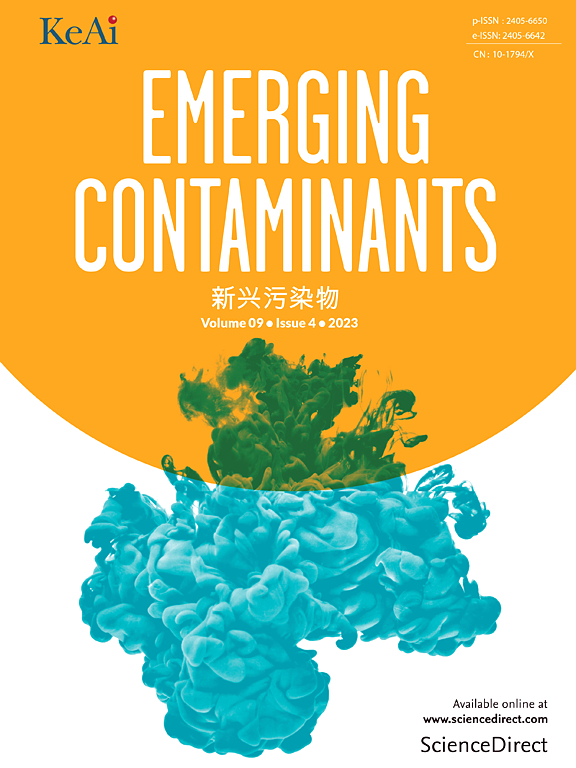内蒙古大型奶牛场及其周边废水中微塑料的调查
IF 6.9
2区 环境科学与生态学
Q1 ENVIRONMENTAL SCIENCES
引用次数: 0
摘要
微塑料(MPs)是塑料废物降解和环境侵蚀产生的微小聚合颗粒,对生态系统、动物健康和人类福祉构成重大威胁。本研究评估了中国内蒙古9个大型奶牛场废水和周围环境中MPs的丰度,重点是氧化池。利用激光直接红外光谱(LDIR)对42份样品进行MPs检测,鉴定出29种聚合物类型,其中聚异戊二烯(22.69%)、聚氯乙烯(16.58%)和聚氨酯(10.47%)最为常见。结果表明,氧化池中MPs丰度较高,但对MPs的去除率仍不理想。为了更好地了解MPs所带来的生态风险,采用了几种污染评价指标来评价其生态影响。评估结果表明,目前的生态风险水平较低,表明MPs对人类健康和环境的直接威胁相对较小。利用正矩阵分解(PMF)模型,深入分析了MPs的来源、组成和分布特征。基于这些发现,本研究将为改进和创新现有的废水处理技术提供见解,以提高MPs的去除效率并为环境保护做出贡献。本文章由计算机程序翻译,如有差异,请以英文原文为准。

A survey of microplastics in wastewater from large-scale dairy farms and their surroundings in inner Mongolia of China
Microplastics (MPs), tiny polymeric particles resulting from the degradation of plastic waste and environmental erosion, pose significant threats to ecosystems, animal health, and human well-being. This study assessed MPs abundance in wastewater and surrounding environments from nine large dairy farms in Inner Mongolia, China, focusing on oxidation ponds. Using laser direct infrared spectroscopy (LDIR), MPs were detected in 42 samples, identifying 29 polymer types, with polyisoprene (22.69 %), polyvinyl chloride (16.58 %), and polyurethane (10.47 %) being the most common. The results revealed a high abundance of MPs in oxidation ponds, while MPs removal efficiency remained unsatisfactory. To better understand the ecological risks posed by MPs, several pollution assessment indices were employed to evaluate their ecological impact. The assessment results indicated that current ecological risk levels were low, suggesting that the immediate threat of MPs to human health and the environment is relatively minor. Using a positive matrix factorization (PMF) model, the sources, composition, and distribution characteristics of MPs were thoroughly analyzed. Based on these findings, this study would provide insights for improving and innovating existing wastewater treatment technologies, with the goal of enhancing MPs removal efficiency and contributing to environmental protection efforts.
求助全文
通过发布文献求助,成功后即可免费获取论文全文。
去求助
来源期刊

Emerging Contaminants
Medicine-Public Health, Environmental and Occupational Health
CiteScore
10.00
自引率
6.70%
发文量
35
审稿时长
44 days
期刊介绍:
Emerging Contaminants is an outlet for world-leading research addressing problems associated with environmental contamination caused by emerging contaminants and their solutions. Emerging contaminants are defined as chemicals that are not currently (or have been only recently) regulated and about which there exist concerns regarding their impact on human or ecological health. Examples of emerging contaminants include disinfection by-products, pharmaceutical and personal care products, persistent organic chemicals, and mercury etc. as well as their degradation products. We encourage papers addressing science that facilitates greater understanding of the nature, extent, and impacts of the presence of emerging contaminants in the environment; technology that exploits original principles to reduce and control their environmental presence; as well as the development, implementation and efficacy of national and international policies to protect human health and the environment from emerging contaminants.
 求助内容:
求助内容: 应助结果提醒方式:
应助结果提醒方式:


